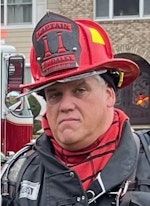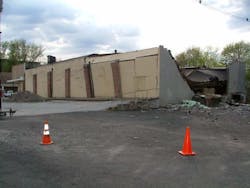Prepping for Shoring Ops at Structural Collapse Incidents
In past articles, we talked about responding to the collapse scene, construction and safety considerations, and training levels for responders. We are going to start covering the operations at the collapse scene, more of the actual steps of the process, so to speak, as to what happens during the incident. That being said, it is not my intent to replace formal training in shoring; there are consistently changing methods and techniques that are evolving in this field, so it is wise to enroll in a solid hands-on application training class that provides the groundwork for building shoring.
Prior to even considering shoring, the Safety Survey is done. The Safety Survey provides confirmed safe zones and hazardous areas to avoid, along with potential victim location for rescuers to focus on (photo 1). This is done by utilizing the acronym L-C-E-S, which stands for:
Lookouts—These are safety officers and trained personnel, utilizing equipment and devices, whose critical functions include identifying potentially dangerous conditions and how to mitigate these issues.
Communications—The formal plan, including what channels each division or group will be operating on. There should also be an agreed upon method of evacuation, and a system to make sure everybody knows it.
Escape Routes—A pre-established path to an area of safety is chosen prior to entering. Make note that the safest exit may not always be the fastest, but it is still the safest. Considering scene dynamics, this route may change as conditions do.
Safe Havens—Identify an area of safety immediately. This could be within the “hot zone” and needs to be passed on to everyone working in the area, especially during changes at the end of operational periods.
The initial step includes a response from the Hazardous Materials responders, to confirm a safe atmospheric condition for operations to begin. Once the area is deemed safe, the search crews and canine search teams begin to search the area for potential victims. Once a potential victim location is detected, it is confirmed with a second search crew. This will serve as an area for rescue operations to commence. This may be one of many areas, but all potential victim locations on scene will have to be addressed.
The collapse scene
Gravity directs compressive forces and energy back into the Earth. Francis Brannigan would consistently preach about the “Gravity Resistance System” incorporated in the structure to keep it upright. For some reason, the resistive system has been compromised, resulting in a collapse, which led to the response of the rescue team. That system failure has placed the building in a compromised imposition of load; components that were designed to be in a specific force can now be placed under undue stress from a different direction, which can cause additional failure of building components. Therefore, shoring will need to be installed to keep the remaining parts of the building up, so that victim removal can be completed. This means that straight walls will not be straight, level floors will be tilted and askew, and roofs and roof loads will be set into arduous positions on the structure (Photo 2). Rescuers will have to apply the proper shoring technique based upon the forces applied to the structural components as dictated by the collapse.
Before committing rescuers to the pile, it is vital to determine the possible cause for the collapse. Buildings fall down for a variety of reasons; in most of our responses, fire is the main cause for the collapse. However, history has dictated that collapses have been caused by a multitude of reasons, such as:
- Building age and deterioration
- Extreme weather conditions (Photo 3)
- Construction accidents/renovations to buildings
- Overloading from changes in occupancy
- Utility failures
- Acts of terrorism
Before committing the troops into battle, the Safety Survey also takes the cause of the collapse into consideration, so that a safe and efficient Incident Action Plan (IAP) can be developed. Additionally, from a design standpoint, materials used in construction were designed to handle specific forces and loads that are placed upon them. Once a system failure occurs, materials can be put into stressed forces that apply a significant strain on the component, and the material of which it is constructed. This is the primary concern that a structural engineer shall be summoned to respond immediately to the scene of a collapse to provide input as to the loading of the compromised structure.
The next step is to identify the severity of the collapse the structure has suffered. These collapses can be categorized as follows:
Global Collapse—There has been a complete and total failure of the “Gravity Resistive System” and the entire structure has fallen (Photo 4).
Partial Collapse—There has been a failure of a specific portion of the structure.
Progressive Collapse—The failure of one component of the structure has impacted additional areas of the structure, causing further component failure (Photo 5).
Secondary Collapse—This frequently occurs after the arrival of responding units, as the loads and stresses on the components begin to shift and cause further component failure.
Application by Action Plan
Once the area is deemed “safe” for rescue operations to commence, a Reconnaissance team is sent in to the hot zone to begin identifying areas of concern for operations to begin. The Recon Team should possess capabilities such as atmospheric monitoring, detailed search operations with thermal imaging cameras, canine search specialists and their accompanying canine, area marking materials and light rescue tools to begin disentanglement. This stage has to move thoroughly and efficiently; it is usually done with a minimal amount of equipment so that the team can move rapidly in the event shifting of the rubble pile starts to occur (Photo 6).
Once Recon has been completed, the next phase, Surface Area Rescue/Removal begins. This phase includes the deployment of rescue teams to begin the process of removing victims at the surface of the rubble pile, who may still need to be disentangled from the rubble (Photo 7). These victims are disentangled while rescuers are setting up tools and supplies for a cutting station, which will be utilized when the rescue teams begin searching voids and collapsed areas of the building where the Recon team has identified potential locations for victims. Bear in mind, even though the victims are on the top level of the debris pile, these victims can still experience significant entanglement issues. That being said, this phase will still require an adequate amount of manpower, equipment and logistical support to complete the mission.
Conclusion
Special operations incidents can tax departments and responders based upon their size, complexity and requirements. Building collapse operations can add complexity and additional concerns that will need to be addressed to free the victim. These incidents can require a broad base of skill sets, from calculating large loads, lifting and moving operations, cribbing and shoring operations, tunneling and void searching operations, and extrication and disentanglement techniques. Furthermore, each step in the operation must be performed in a rescue arena that has already been compromised from the initial collapse, and has significant potential for secondary collapse. Next month, we will delve into the next phase of the operation, Void Searches, and the shoring support that is needed to clear these areas of victim entrapment.
Until next time, stay focused and stay safe.

Michael Daley
MICHAEL DALEY, who is a Firehouse contributing editor, is a 37-year veteran who serves as a captain and department training officer in Monroe Township, NJ. He is a staff instructor at multiple New Jersey fire academies and is an adjunct professor in the Fire Science Program at Middlesex County College. Daley is a nationally known instructor who has presented at multiple conferences, including Firehouse Expo and Firehouse World. His education includes accreditations as a Chief Training Officer and a Fire Investigator, and he completed the Craftsman Level of education with Project Kill the Flashover. Daley is a member of the Institution of Fire Engineers and a FEMA Instructor and Rescue Officer with NJ Urban Search and Rescue Task Force 1. He operates Fire Service Performance Concepts, which is a training and research firm that delivers and develops training courses in many fire service competencies.






